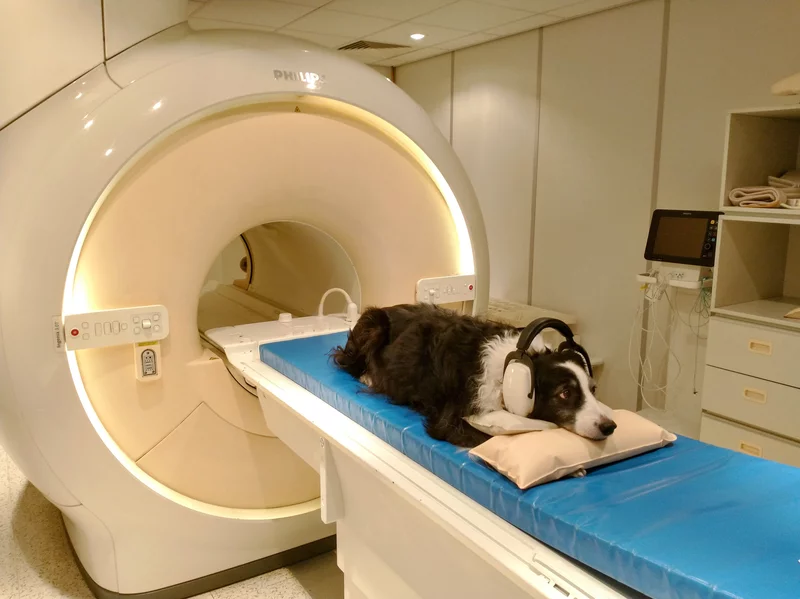I am multilingual and consider myself a native Greek and English speaker. People like Ziad Fazah, born in Liberia, famously speak a total of 59 world languages. Can other creatures share that ability, though? Specifically, can dogs understand more than one language?
Well, wonder no more! As the NPR reports, new research published this week in the journal NeuroImage confirms that yes, they do.
When Laura Cuaya moved from Mexico to Hungary to work as a brain researcher at the Neuroethology of Communication Lab at Eötvös Loránd University in Budapest, she encountered a new language. In her words,
When I moved from Mexico to Hungary to start my post-doc research, all was new for me. Obviously, here, people in Budapest speak Hungarian. So you’ve had a different language, completely different for me.
The language was also new to her two dogs: Kun Kun and Odín.

Kun Kun gets ready for a test to tell if dogs can distinguish languages from each other. Photo: Raúl Hernández via NPR
The Little Prince
“People are super friendly with their dogs [in Budapest]. And my dogs, they are interested in interacting with people,” Cuaya said. “But I wonder, did they also notice people here … spoke a different language?”
Cuaya set out to find the answer. She and her colleagues designed an experiment with 18 volunteer dogs — including her two border collies — to see if they could differentiate between two languages. Kun Kun and Odín were used to hearing Spanish; the other dogs, Hungarian.
The dogs sat still within an MRI machine while listening to an excerpt from the story The Little Prince. They heard one version in Spanish, and another in Hungarian. Then the scientists analyzed the dogs’ brain activity.
Attila Andics leads the lab where the study took place and said researchers were looking for brain regions that showed a different activity pattern for one language versus the other.
“And we found a brain region — the secondary auditory cortex, which is a higher-level processing region in the auditory hierarchy — which showed a different activity pattern for the familiar language and for the unfamiliar language,” Andics said.
“This activity pattern difference to the two languages suggests that dogs’ brains can differentiate between these two languages. In terms of brain imaging studies, this study is the very first one which showed that a non-human species brain can discriminate between languages.”
They also found that older dogs brains’ showed bigger differences in brain activity between the two languages, perhaps because older dogs have more experience listening to human language.





My cats understand the words ‘food’ and ‘tuna’ in German, English and Bulgarian. 😀
Now, that’s impressive!
Yes!
Brief and to the point 🙂
Barking is a complex communication considering the multi-language dog owners.🤔
Fascinating, but not surprising, Nicholas. Dogs (animals in general) are much more perceptive than we think. 🙂
I just asked Izzy and she agrees with you 🙂
I saw that same story reposted on a mainstream news site. Border collies are famously known as very smart dogs. Cute too; had one in our old neighborhood.
True, they are the smartest breed, I believe. Also, the stillest one, it seems: I doubt that Izzy would stay in that MRI machine for a second!
They do seem very well behaved with a bit of training.
I’m more surprised that the dogs lay there as required for so long.
Lol – to be honest, that astounded me, too, as none of our dogs could ever pull such a feat!
Our family pets both understand 2+ languages as our family talk to them in whatever language that comes to mind over the years. I know the pets understand but they just like to use pleading eyes and selective hearing like little kids to get things their way..
Lol – that’s my experience as well 😀
This is interesting. But wouldn’t their brains just be marking the words that are unfamiliar to them just as ours would – so they can try to put meaning to them. I don’t think if you gave them a list of words they learned after being exposed to the new language that they would have different activity than they do with their native-heard language. Languages, after all, are just series of sounds and silences. The only way we truly differentiate them is we are able to define a language by its name, such as ‘Greek’ when we learn to identify enough words that fit the pattern we define with that word.
So I suspect, if you gave the dogs one more reading in a third language, that the second and third language (both unfamiliar to them) would create the same brain activity as each other. In other words, I project that they would be unable to differentiate one new language from the other new language – but humans could.
If the study showed a different brain activity for each of two new languages simultaneously then I think this conclusion would make more sense. And they just may be that smart! 🙂
An excellent question, Sheri! The researchers are continuing their studies to answer questions like this. I’ll let you know when they publish their findings 🙂